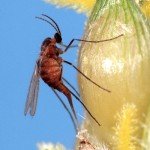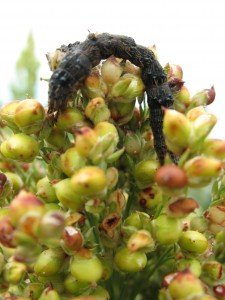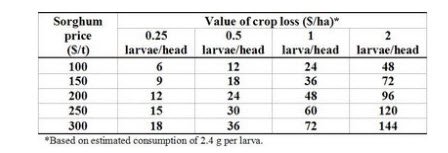As crops come into head and start to fill grain, sorghum midge and helicoverpa will start to infest crops. Making a decision about when control is warranted is made somewhat easier with the availability of economic threshold calculators now available on the Beatsheet Blog (https://thebeatsheet.com.au/sampling-2/); or use the ready reckoners in this article.
MANAGEMENT OF SORGHUM MIDGE
How to count for midge
Often the first midge seen are caught in spiders webs in the field – a sign that midge are active. Generally, peak midge activity occurs between 9 and 11 am, and this is the best time to look. However changes in weather can bring midge into a field from surrounding areas (Johnson grass, earlier sorghum crops) at any time of day. Midge numbers can vary widely both within a crop and between plants, this makes the thorough sampling critical to estimate midge abundance.
Sorghum heads are most attractive to midge at mid flower. It is not uncommon to see double or triple the number of midge on panicles at early-mid flower compared with the end of flowering. At lower midge densities, adult flies will move around and lay almost exclusively on the flowering portion of the panicle.
Midge flies are only 1-2 mm long, and it is very easy to underestimate midge numbers if you are not careful. The easiest way to ‘get your eye in’ is to look at the top half of mid flowering panicles and look for MOVEMENT of the small red flies against a still sorghum panicle looking from side on and slightly above side on one section of the sorghum panicle at a time. Keep your eyes focused over a couple of branches of florets for several seconds at a time to detect female midge walking around the branch or bobbing up and down probing their ovipositor into each floret. On windy days you may have to hold each head still and shelter the panicle with your body before examining each panicle.
Monitor for midge over 10 metres of row in at least 4 different locations in your crop. Use the average midge density in the economic threshold calculator or ready reckoner.
As the season progresses, you may also start to see the black midge parasitoid, Eupelmus spp . Whilst it can be present in reasonably large numbers, this parasitoid does not occur early enough to prevent midge from causing damage. It can also be confused with midge, so be sure to look for the reddish abdomen of the midge, not just little black ‘flies’.
Managing midge in sorghum
Insecticides only kill the adult midge as they move about the crop and do not kill the eggs or hatched larvae that are already present inside the sorghum florets. While midge adults only live for one day, they do most of their egg laying (and subsequent damage to the crop) in the morning.
It is possible to calculate theoretical yield loss estimates for a particular crop senario (see table). These yield loss estimates are based on extensive field trials that determined the average yield losses per midge per day on different rated midge hybrids. The on-line calculator uses the data you enter to determine if the potential yield loss is greater than the cost of control.
The yield loss estimates in the table assume that spraying results in a 100% kill and that there is no midge damage prior to chemical application. It also assumes that you will receive the same average midge pressures over 4-5 days. In reality research has shown that one well timed insecticide for midge (put on from panicle emergence and before midge even enter the crop) will still only prevent 70-80% damage protection in lower rated sorghum hybrids. In 8 rated hybrids, yield losses can be reduced by over 90% with this spray timing.
Implications of midge control for other pests (helicoverpa and Rutherglen bug)
Often a spray for midge (synthetic pyrethroid) will be combined with a virus application for helicoverpa. Whilst the synthetic pyrethroid will have efficacy against midge and Rutherglen bug, it will devastate beneficial insect population. As a result, there may be implications for the ongoing control of helicoverpa populations in the crop. Larvae that survive a spray are more likely to go on and cause damage to maturing grain following a pyrethroid application because predators and parasitoids that might have otherwise killed them will be much less abundant. Because of the depletion of beneficial insects, another potential downside of midge and Rutherglen bug control with pyrethroids is the flaring of aphids which may cause stickiness issues at harvest.
HELICOVERPA MANAGEMENT IN SORGHUM
Virus is the most commonly used control option for helicoverpa in sorghum. It is highly effective, and has the benefit of preserving beneficials, which then contribute to the suppression of surviving helicoverpa and aphids in the crop. To determine whether the helicoverpa infestation is likely to cause significant economic loss, use the threshold calculator, or the ready-reckoner below.
Recommendations for the use of low volume aerial applications of Vivus Max in sorghum have recently been revised, and it is worth highlighting them. Whilst most NPV use in sorghum would have been without an additive, the revised recommendation for low volume applications suggests the inclusion of an additive. Recommendations for the use of NPV applied at higher volumes (by ground) have not changed, and there is no evidence that the inclusion of an additive is required to get high levels of efficacy.
Low water application volumes (down to 10 L per hectare) can be used successfully with Vivus Max with benefits in terms of timely application and being able to get over large areas of crop quickly and in wet conditions. However, low volumes increase the risk of poor coverage, particularly through droplet evaporation.
The inclusion of Optimol is recommended in low volume applications at a rate of 1 L/ha. In other words, 9 L water per hectare + 1 L Optimol per hectare + Vivus Max*
(* Important Note: Vivus Max + Optimol at 10 L per hectare in sorghum is subject to APVMA approval – expected March 2013)
For information on the activity of Optimol, go to the AgBitech website. www.agbitech.com




